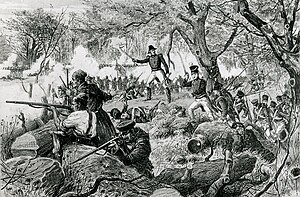| Battle of the Chateauguay | |||||||
|---|---|---|---|---|---|---|---|
| Part of the War of 1812 | |||||||
 Bataille de la Chateauguay by Henri Julien. Lithograph from Le Journal de Dimanche, 1884. | |||||||
| |||||||
| Belligerents | |||||||
|
|
| ||||||
| Commanders and leaders | |||||||
|
|
| ||||||
| Strength | |||||||
| 1,530[1] | 2,600[2] | ||||||
| Casualties and losses | |||||||
|
2 killed 16 wounded 4 missing[3][4] |
23 killed | ||||||
| Official name | Battle of the Châteauguay National Historic Site of Canada | ||||||
| Designated | 1920 | ||||||
Location within Quebec | |||||||
The Battle of the Chateauguay was an engagement of the War of 1812. On 26 October 1813, a combined British and Canadian force consisting of 1,530 regulars, volunteers, militia and Mohawk warriors from Lower Canada, commanded by Charles de Salaberry, repelled an American force of about 2,600 regulars which was attempting to invade Lower Canada and ultimately attack Montreal.
The Battle of the Chateauguay was one of the two battles (the other being the Battle of Crysler's Farm) which caused the Americans to abandon the Saint Lawrence Campaign, their major strategic effort in the autumn of 1813.
